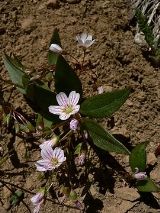
Claytonia lanceolata
Encyclopedia
Claytonia lanceolata is a species of wildflower in the purslane family
known by the common names lanceleaf springbeauty and western springbeauty. This plant is native to western North America as far south as New Mexico
where it grows in foothills up to alpine slopes. It thrives in the rocky soil of alpine climate
s where the snow never melts. It is a perennial herb growing from a tuber
one to three centimeters wide. It produces a short, erect stem reaching a maximum height of 15 centimeters. At its smallest the plant bears only its first two rounded leaves before flowering and dying back.Its thick leaves are helpful for storing water. If it continues to grow it produces thick, lance-shaped leaves further up the stem. The star-shaped flowers come in inflorescence
s of three to 15 blooms and they are white or pink, often with veiny stripes and yellow blotches near the base of each petal. The fruit is a small capsule containing 2 seeds, which are black and shiny. The Okanagon-Colville, Okanagon, and Thompson Native American peoples used the tuber of this plant for food and for animal fodder. There are 28 species of this plant spread across North America and East Asia.
Portulacaceae
Portulacaceae are a family of flowering plants, comprising about 20 genera with about 500 species, ranging from herbaceous plants to shrubs. The family has been recognised by most taxonomists, and is also known as the purslane family; it has a cosmopolitan distribution, with the highest diversity...
known by the common names lanceleaf springbeauty and western springbeauty. This plant is native to western North America as far south as New Mexico
New Mexico
New Mexico is a state located in the southwest and western regions of the United States. New Mexico is also usually considered one of the Mountain States. With a population density of 16 per square mile, New Mexico is the sixth-most sparsely inhabited U.S...
where it grows in foothills up to alpine slopes. It thrives in the rocky soil of alpine climate
Alpine climate
Alpine climate is the average weather for a region above the tree line. This climate is also referred to as mountain climate or highland climate....
s where the snow never melts. It is a perennial herb growing from a tuber
Tuber
Tubers are various types of modified plant structures that are enlarged to store nutrients. They are used by plants to survive the winter or dry months and provide energy and nutrients for regrowth during the next growing season and they are a means of asexual reproduction...
one to three centimeters wide. It produces a short, erect stem reaching a maximum height of 15 centimeters. At its smallest the plant bears only its first two rounded leaves before flowering and dying back.Its thick leaves are helpful for storing water. If it continues to grow it produces thick, lance-shaped leaves further up the stem. The star-shaped flowers come in inflorescence
Inflorescence
An inflorescence is a group or cluster of flowers arranged on a stem that is composed of a main branch or a complicated arrangement of branches. Strictly, it is the part of the shoot of seed plants where flowers are formed and which is accordingly modified...
s of three to 15 blooms and they are white or pink, often with veiny stripes and yellow blotches near the base of each petal. The fruit is a small capsule containing 2 seeds, which are black and shiny. The Okanagon-Colville, Okanagon, and Thompson Native American peoples used the tuber of this plant for food and for animal fodder. There are 28 species of this plant spread across North America and East Asia.

